headlamp KIA CADENZA 2020 Owners Manual
[x] Cancel search | Manufacturer: KIA, Model Year: 2020, Model line: CADENZA, Model: KIA CADENZA 2020Pages: 560, PDF Size: 11.37 MB
Page 157 of 560
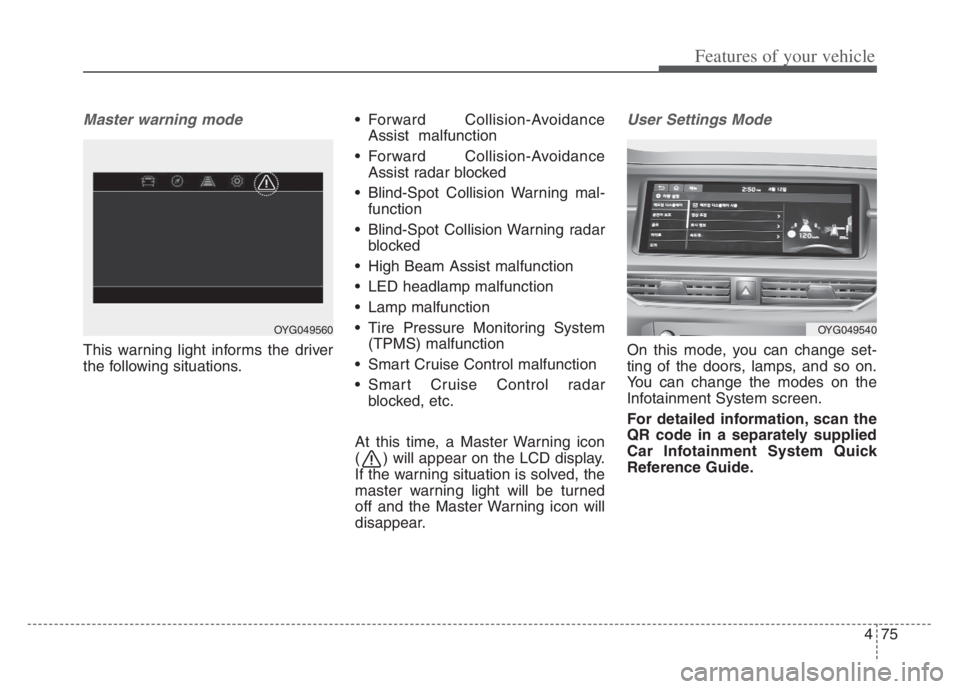
475
Features of your vehicle
Master warning mode
This warning light informs the driver
the following situations. Forward Collision-Avoidance
Assist malfunction
Forward Collision-Avoidance
Assist radar blocked
Blind-Spot Collision Warning mal-
function
Blind-Spot Collision Warning radar
blocked
High Beam Assist malfunction
LED headlamp malfunction
Lamp malfunction
Tire Pressure Monitoring System
(TPMS) malfunction
Smart Cruise Control malfunction
Smart Cruise Control radar
blocked, etc.
At this time, a Master Warning icon
( ) will appear on the LCD display.
If the warning situation is solved, the
master warning light will be turned
off and the Master Warning icon will
disappear.
User Settings Mode
On this mode, you can change set-
ting of the doors, lamps, and so on.
You can change the modes on the
Infotainment System screen.
For detailed information, scan the
QR code in a separately supplied
Car Infotainment System Quick
Reference Guide.
OYG049540OYG049560
Page 167 of 560
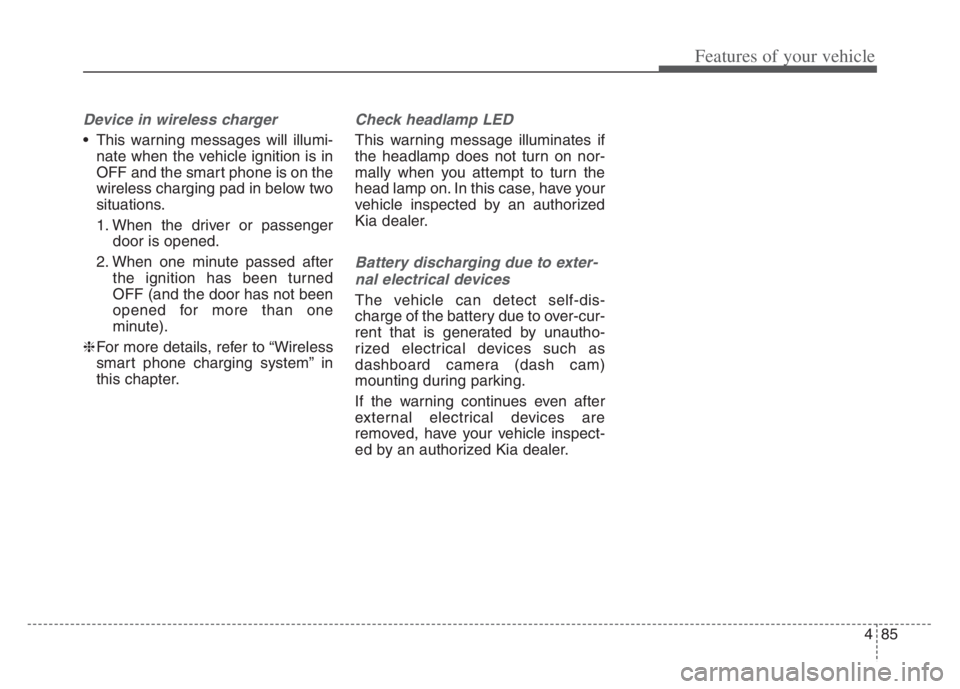
485
Features of your vehicle
Device in wireless charger
This warning messages will illumi-
nate when the vehicle ignition is in
OFF and the smart phone is on the
wireless charging pad in below two
situations.
1. When the driver or passenger
door is opened.
2. When one minute passed after
the ignition has been turned
OFF (and the door has not been
opened for more than one
minute).
❈For more details, refer to “Wireless
smart phone charging system” in
this chapter.
Check headlamp LED
This warning message illuminates if
the headlamp does not turn on nor-
mally when you attempt to turn the
head lamp on. In this case, have your
vehicle inspected by an authorized
Kia dealer.
Battery discharging due to exter-
nal electrical devices
The vehicle can detect self-dis-
charge of the battery due to over-cur-
rent that is generated by unautho-
rized electrical devices such as
dashboard camera (dash cam)
mounting during parking.
If the warning continues even after
external electrical devices are
removed, have your vehicle inspect-
ed by an authorized Kia dealer.
Page 175 of 560
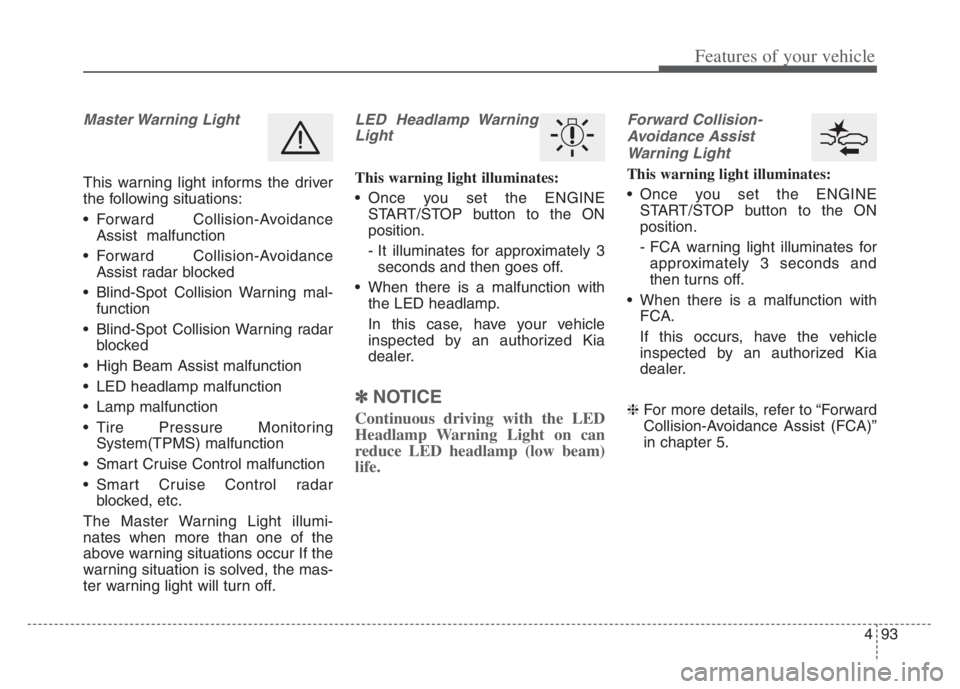
493
Features of your vehicle
Master Warning Light
This warning light informs the driver
the following situations:
Forward Collision-Avoidance
Assist malfunction
Forward Collision-Avoidance
Assist radar blocked
Blind-Spot Collision Warning mal-
function
Blind-Spot Collision Warning radar
blocked
High Beam Assist malfunction
LED headlamp malfunction
Lamp malfunction
Tire Pressure Monitoring
System(TPMS) malfunction
Smart Cruise Control malfunction
Smart Cruise Control radar
blocked, etc.
The Master Warning Light illumi-
nates when more than one of the
above warning situations occur If the
warning situation is solved, the mas-
ter warning light will turn off.
LED Headlamp Warning
Light
This warning light illuminates:
Once you set the ENGINE
START/STOP button to the ON
position.
- It illuminates for approximately 3
seconds and then goes off.
When there is a malfunction with
the LED headlamp.
In this case, have your vehicle
inspected by an authorized Kia
dealer.
✽ ✽
NOTICE
Continuous driving with the LED
Headlamp Warning Light on can
reduce LED headlamp (low beam)
life.
Forward Collision-
Avoidance Assist
Warning Light
This warning light illuminates:
Once you set the ENGINE
START/STOP button to the ON
position.
- FCA warning light illuminates for
approximately 3 seconds and
then turns off.
When there is a malfunction with
FCA.
If this occurs, have the vehicle
inspected by an authorized Kia
dealer.
❈ For more details, refer to “Forward
Collision-Avoidance Assist (FCA)”
in chapter 5.
Page 199 of 560

4117
Features of your vehicle
High beam operation
To turn on the high beam headlamp,
push the lever away from you. The lever
will return to its original position. The
high beam indicator will light when the
headlight high beams are switched on.
To turn off the high beam headlamps,
pull the lever towards you. It will return
to the normal (low beam) position
when released.
To prevent the battery from being
discharged, do not leave the lights
on for a prolonged time while the
engine is not running.
WARNING - High beams
Do not use high beam when
there are other vehicles in front
of your vehicle. Using high
beam could obstruct the other
driver’s vision.
OYG040637N
CAUTION
Never place anything over the
sensor (1) located on the
instrument panel, this will
ensure better auto-light sys-
tem control.
Don’t clean the sensor using a
window cleaner, the cleaner
may leave a light film which
could interfere with sensor
operation.
Page 200 of 560
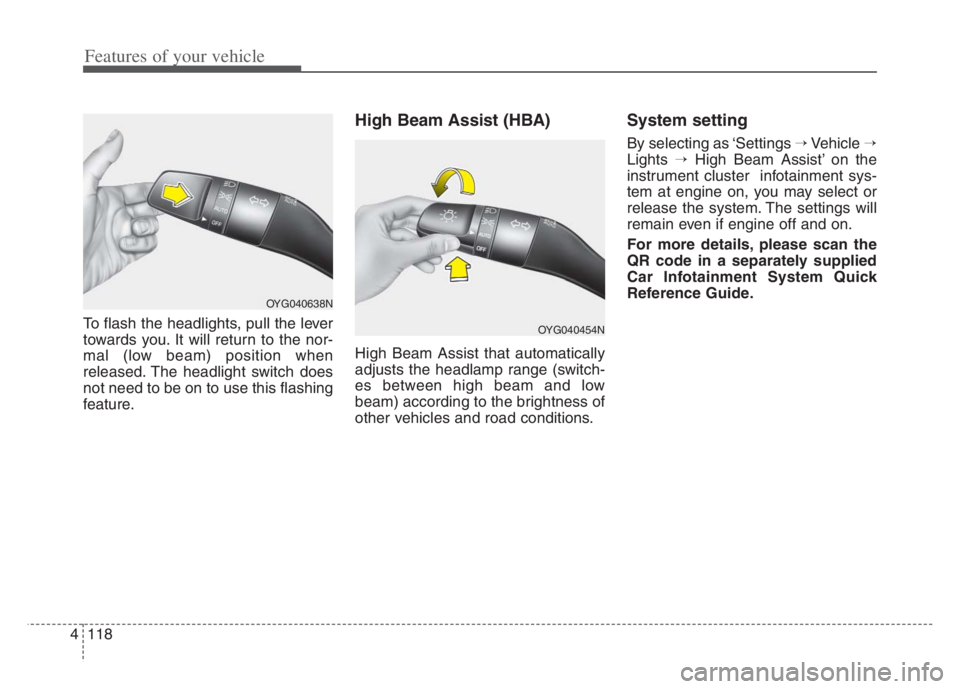
Features of your vehicle
118 4
To flash the headlights, pull the lever
towards you. It will return to the nor-
mal (low beam) position when
released. The headlight switch does
not need to be on to use this flashing
feature.
High Beam Assist (HBA)
High Beam Assist that automatically
adjusts the headlamp range (switch-
es between high beam and low
beam) according to the brightness of
other vehicles and road conditions.
System setting
By selecting as ‘Settings →Vehicle →
Lights →High Beam Assist’ on the
instrument cluster infotainment sys-
tem at engine on, you may select or
release the system. The settings will
remain even if engine off and on.
For more details, please scan the
QR code in a separately supplied
Car Infotainment System Quick
Reference Guide.
OYG040454N
OYG040638N
Page 201 of 560

4119
Features of your vehicle
Operating condition
1.Place the light switch in the AUTO
position.
2.Turn on the high beam by pushing
the lever away from you.
The High Beam Assist ( ) indica-
tor will illuminate.
3.The High Beam Assist ( ) indica-
tor will illuminate.
4.High Beam Assist will turn on when
vehicle speed is above 25 mph (40
km/h).
5.The details of operation with the
light switch while High Beam Assist
is on are below.
1) If the light switch is pushed
away, High Beam Assist will turn
off and the high beam will be on
continuously.
2) If the light switch is pulled
towards you when the high
beam is off, the high beam will
be on without cancellation of
High Beam Assist. (When you
hands off, the lever will move to
the middle and the high beam
will turn off.)3) If the light switch is pulled
towards you when the high
beam is on by High Beam
Assist, the low beam will be on
and High Beam Assist will turn
off.
4) If the light switch is turned to the
headlamp position ( ) AUTO
position, High Beam
Assist will turn off and the low
beam will be on continuously.When High Beam Assist is operat-
ing, the high beam switches to low
beam in the below conditions.
When the headlamp is detected
from the on-coming vehicle.
When the tail lamp is detected
from the front vehicle.
When headlamp/tail lamp of bicy-
cle/motorcycle is detected.
When the surrounding is so bright
that high beams are not needed.
When streetlights or other lights
are detected.
When the light switch is not in the
AUTO position.
When High Beam Assist is off.
When vehicle speed is below 15
mph (24 km/h).
Page 202 of 560
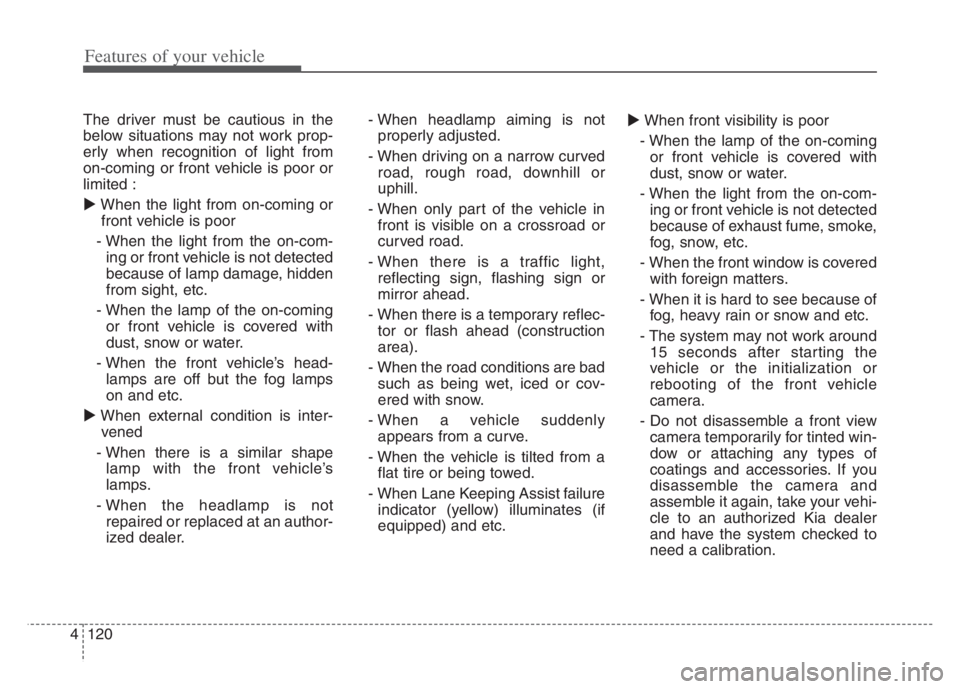
Features of your vehicle
120 4
The driver must be cautious in the
below situations may not work prop-
erly when recognition of light from
on-coming or front vehicle is poor or
limited :
When the light from on-coming or
front vehicle is poor
- When the light from the on-com-
ing or front vehicle is not detected
because of lamp damage, hidden
from sight, etc.
- When the lamp of the on-coming
or front vehicle is covered with
dust, snow or water.
- When the front vehicle’s head-
lamps are off but the fog lamps
on and etc.
When external condition is inter-
vened
- When there is a similar shape
lamp with the front vehicle’s
lamps.
- When the headlamp is not
repaired or replaced at an author-
ized dealer.- When headlamp aiming is not
properly adjusted.
- When driving on a narrow curved
road, rough road, downhill or
uphill.
- When only part of the vehicle in
front is visible on a crossroad or
curved road.
- When there is a traffic light,
reflecting sign, flashing sign or
mirror ahead.
- When there is a temporary reflec-
tor or flash ahead (construction
area).
- When the road conditions are bad
such as being wet, iced or cov-
ered with snow.
- When a vehicle suddenly
appears from a curve.
- When the vehicle is tilted from a
flat tire or being towed.
- When Lane Keeping Assist failure
indicator (yellow) illuminates (if
equipped) and etc.When front visibility is poor
- When the lamp of the on-coming
or front vehicle is covered with
dust, snow or water.
- When the light from the on-com-
ing or front vehicle is not detected
because of exhaust fume, smoke,
fog, snow, etc.
- When the front window is covered
with foreign matters.
- When it is hard to see because of
fog, heavy rain or snow and etc.
- The system may not work around
15 seconds after starting the
vehicle or the initialization or
rebooting of the front vehicle
camera.
- Do not disassemble a front view
camera temporarily for tinted win-
dow or attaching any types of
coatings and accessories. If you
disassemble the camera and
assemble it again, take your vehi-
cle to an authorized Kia dealer
and have the system checked to
need a calibration.
Page 204 of 560
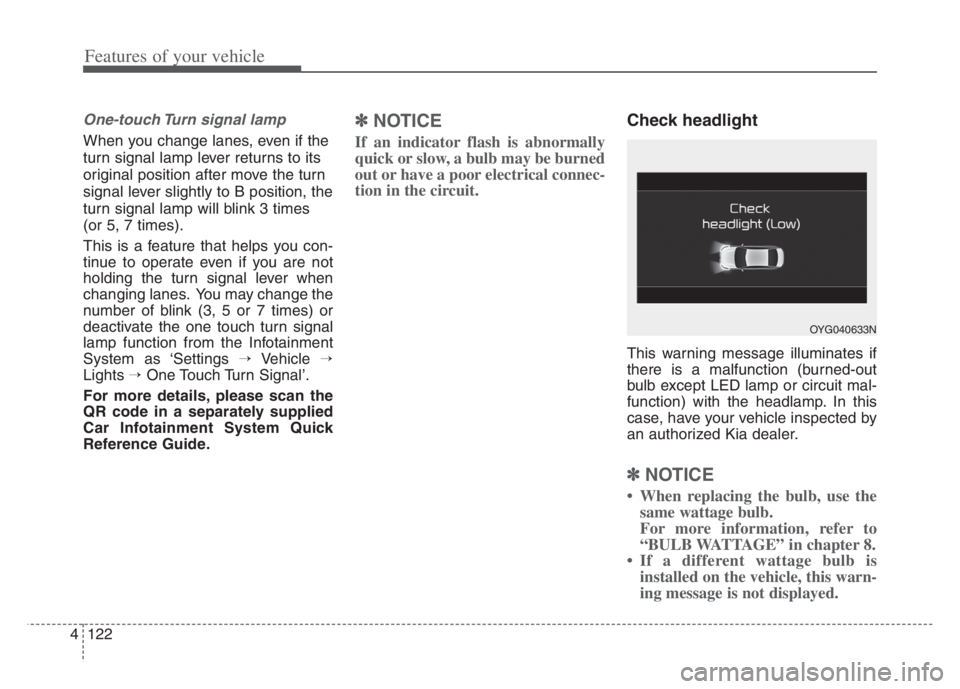
Features of your vehicle
122 4
One-touch Turn signal lamp
When you change lanes, even if the
turn signal lamp lever returns to its
original position after move the turn
signal lever slightly to B position, the
turn signal lamp will blink 3 times
(or 5, 7 times).
This is a feature that helps you con-
tinue to operate even if you are not
holding the turn signal lever when
changing lanes. You may change the
number of blink (3, 5 or 7 times) or
deactivate the one touch turn signal
lamp function from the Infotainment
System as ‘Settings →Vehicle →
Lights →One Touch Turn Signal’.
For more details, please scan the
QR code in a separately supplied
Car Infotainment System Quick
Reference Guide.
✽ ✽
NOTICE
If an indicator flash is abnormally
quick or slow, a bulb may be burned
out or have a poor electrical connec-
tion in the circuit.
Check headlight
This warning message illuminates if
there is a malfunction (burned-out
bulb except LED lamp or circuit mal-
function) with the headlamp. In this
case, have your vehicle inspected by
an authorized Kia dealer.
✽ ✽
NOTICE
• When replacing the bulb, use the
same wattage bulb.
For more information, refer to
“BULB WATTAGE” in chapter 8.
• If a different wattage bulb is
installed on the vehicle, this warn-
ing message is not displayed.
OYG040633N
Page 308 of 560
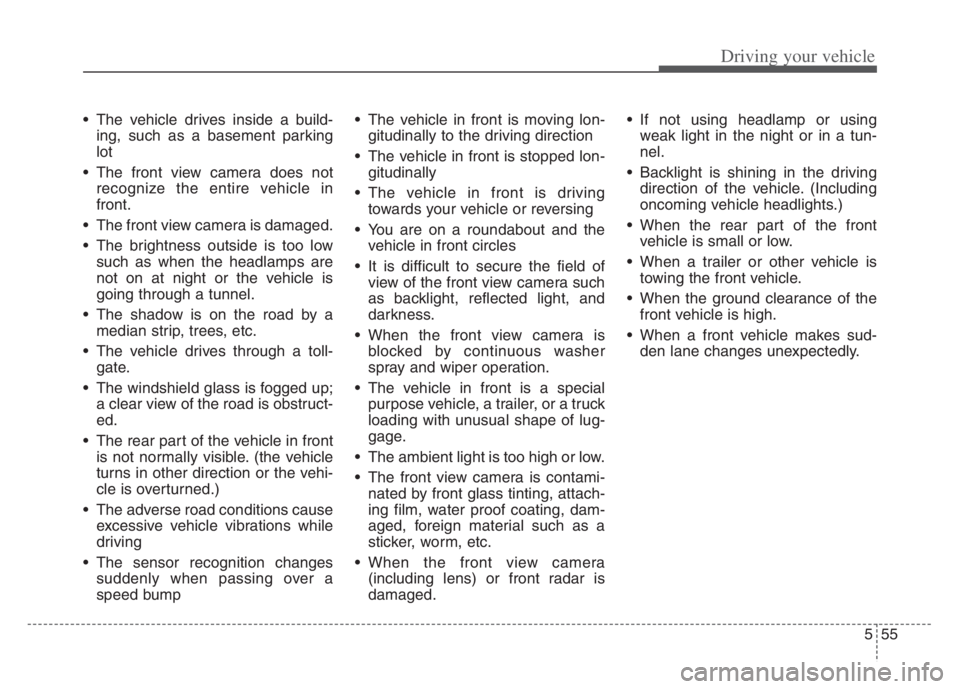
555
Driving your vehicle
The vehicle drives inside a build-
ing, such as a basement parking
lot
The front view camera does not
recognize the entire vehicle in
front.
The front view camera is damaged.
The brightness outside is too low
such as when the headlamps are
not on at night or the vehicle is
going through a tunnel.
The shadow is on the road by a
median strip, trees, etc.
The vehicle drives through a toll-
gate.
The windshield glass is fogged up;
a clear view of the road is obstruct-
ed.
The rear part of the vehicle in front
is not normally visible. (the vehicle
turns in other direction or the vehi-
cle is overturned.)
The adverse road conditions cause
excessive vehicle vibrations while
driving
The sensor recognition changes
suddenly when passing over a
speed bump The vehicle in front is moving lon-
gitudinally to the driving direction
The vehicle in front is stopped lon-
gitudinally
The vehicle in front is driving
towards your vehicle or reversing
You are on a roundabout and the
vehicle in front circles
It is difficult to secure the field of
view of the front view camera such
as backlight, reflected light, and
darkness.
When the front view camera is
blocked by continuous washer
spray and wiper operation.
The vehicle in front is a special
purpose vehicle, a trailer, or a truck
loading with unusual shape of lug-
gage.
The ambient light is too high or low.
The front view camera is contami-
nated by front glass tinting, attach-
ing film, water proof coating, dam-
aged, foreign material such as a
sticker, worm, etc.
When the front view camera
(including lens) or front radar is
damaged. If not using headlamp or using
weak light in the night or in a tun-
nel.
Backlight is shining in the driving
direction of the vehicle. (Including
oncoming vehicle headlights.)
When the rear part of the front
vehicle is small or low.
When a trailer or other vehicle is
towing the front vehicle.
When the ground clearance of the
front vehicle is high.
When a front vehicle makes sud-
den lane changes unexpectedly.
Page 322 of 560
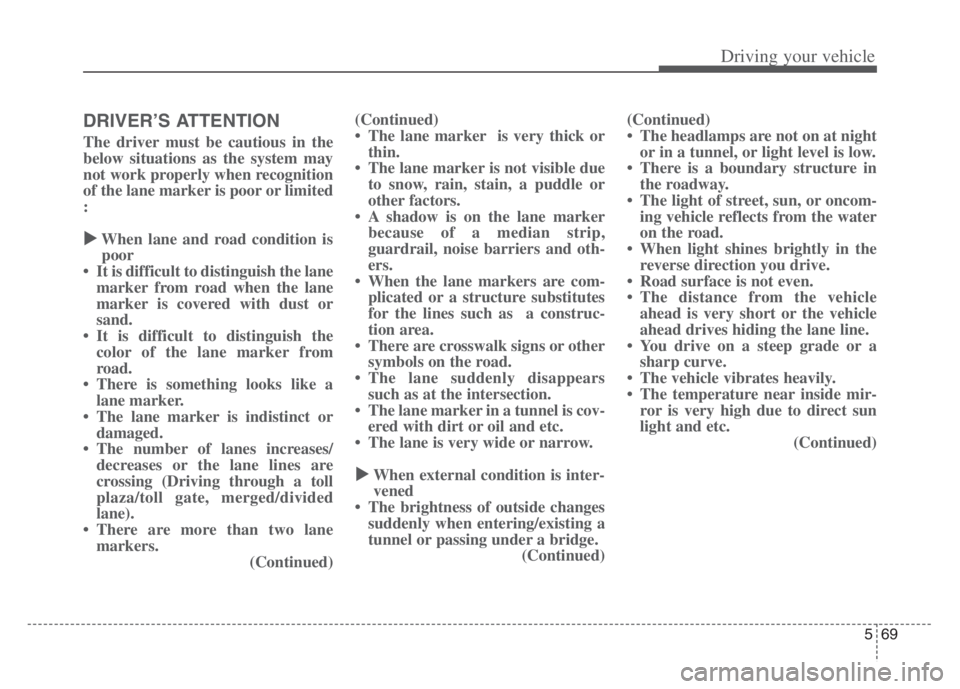
569
Driving your vehicle
DRIVER’S ATTENTION
The driver must be cautious in the
below situations as the system may
not work properly when recognition
of the lane marker is poor or limited
:
When lane and road condition is
poor
• It is difficult to distinguish the lane
marker from road when the lane
marker is covered with dust or
sand.
• It is difficult to distinguish the
color of the lane marker from
road.
• There is something looks like a
lane marker.
• The lane marker is indistinct or
damaged.
• The number of lanes increases/
decreases or the lane lines are
crossing (Driving through a toll
plaza/toll gate, merged/divided
lane).
• There are more than two lane
markers.
(Continued)(Continued)
• The lane marker is very thick or
thin.
• The lane marker is not visible due
to snow, rain, stain, a puddle or
other factors.
• A shadow is on the lane marker
because of a median strip,
guardrail, noise barriers and oth-
ers.
• When the lane markers are com-
plicated or a structure substitutes
for the lines such as a construc-
tion area.
• There are crosswalk signs or other
symbols on the road.
• The lane suddenly disappears
such as at the intersection.
• The lane marker in a tunnel is cov-
ered with dirt or oil and etc.
• The lane is very wide or narrow.
When external condition is inter-
vened
• The brightness of outside changes
suddenly when entering/existing a
tunnel or passing under a bridge.
(Continued)(Continued)
• The headlamps are not on at night
or in a tunnel, or light level is low.
• There is a boundary structure in
the roadway.
• The light of street, sun, or oncom-
ing vehicle reflects from the water
on the road.
• When light shines brightly in the
reverse direction you drive.
• Road surface is not even.
• The distance from the vehicle
ahead is very short or the vehicle
ahead drives hiding the lane line.
• You drive on a steep grade or a
sharp curve.
• The vehicle vibrates heavily.
• The temperature near inside mir-
ror is very high due to direct sun
light and etc.
(Continued)